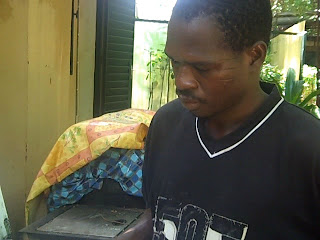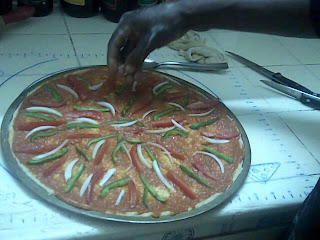Marcel dans la cuisine/Marcel in the kitchen

For such a great price, and what I convinced myself could technically be considered a culinary "cultural" experience, I gave her a definitive "hell yes." I would love Marcel to come on over and get cookin’. Not to mention I had already burned now 3 attempts at dinner = 2 pots of beans + 1 pot of jambalaya mix I’d brought from home.
My new chef has been coming in on Monday, Wednesday, and Friday mornings. When he arrives at around 7:30AM, we decide what he’ll make that day, what he needs to buy at the market, and how much I need to give him to buy “ces provisions.” Having him do the food purchasing saves me some cash; he gets the African price, whereas "toute seule"/by myself I'm almost always charged the “tubab” price, faring at about double.
Monsieur Marcel has thrown together all sorts of Malian dishes: "sauce feuilles"/leaf sauce, made with either spinach or potato leaves; “les allocos”/plaintains either deep-fried (deeply-awesome) or grilled; “aubergines”/eggplant and “gombo”/okra fixed every which way; “le poisson capitaine,” the most popular fish around Bamako; or one of my favorites, a sort of mélange of all of the above which he calls “sauce feuilles du bissap avec arrachides et le petit poisson sur le riz,” a sauce of hibiscus leaves and peanuts with "small" fish over rice.
Sauce feuilles in the making on the outdoor stove

My investment in Marcel has not only paid off in grocery shopping and food preparation, but also in juices. The first month of my trip, before he entered my life, I had spent the majority of my “liquid” assets on liquids. I just couldn’t get enough of the fresh juices around town: banana juice, mango juice, guava juice, bissap (hibiscus juice), and my favorite, “jus de pain de singe”/monkey’s bread juice/baobab juice. All of the drinking calories saved from leaving beer and liquor behind in Louisiana had simply found a new home in juice cals, which are now created by Monsieur Marcel.
So I’ve been eating AND drinking well, in full out Malian style (although without the meat that Malians love so). But to top it off, when I’m feeling a little more American, or needing a break from rice life, Marcel makes one killer vegetarian pizza.
I was looking for any excuse to give my new angel Marcel, who has saved me from myself in the kitchen, some extra cash in appreciation. It was this very home-made pizza that inspired me to ask him for a proper cooking lesson in exchange for some extra dough, which I found would be in cash and pizza form.
Pizza had become a staple in my pre-Mali life. My old roommate, Jen Linder, and I had gotten into the routine of Sunday pizza back in NOLA. We would flip between getting the greasiest pizza we could find, Pizza Hut(until we discovered Domino’s new recipe), and trying to feel better about our pizza choices by ordering the “World’s Healthiest Pizza," with its acclaimed probiotic crust. But what if we could make our own pizza back on Sundays in the dirty? Then we could put the money saved BACK into more beer purchases!
Sunday was the big lesson. Marcel and I started by adding the flour in a bowl for the dough. And then we stopped.
The flour was moving, ever so slightly. “Tu vois, Liza? (always pronounced Lee-zuh) C’est vermin.” Small bugs had gotten into the flour to reproduce, and now the tiny worm-like offspring were preventing us from continuing with our lesson.
At least, for a little while. Marcel was used to this kind of thing. He whipped out a sieve, and a few minutes of sifting later we were back at it.
When the dough was finished, we let it rise for a period of time while we made the homemade tomato sauce. We blended tomatoes together with a bell pepper and garlic, added the secret ingredient, and placed the mix onto the stove. Secret ingredient of the sauce? Maggi, bien sûr!
While the sauce was simmering, I had to ask: where did this West African native learn to make such a good pizza? Marcel replied that in his home country Burkina Fasso, he had worked as a domestic cook for one particular development worker. She was moving to Germany for a new job, and asked him to come with her to continue cooking for her. Six years later he moved home to Burkina to take care of his mother after his father had passed away. When he came home, he brought with him a mastery of German cuisine and -- you guessed it -- some serious pizza skillz.
We rolled out the pizza dough and I then asked him what the markings on his face were from. He has three on each side of his face outside of his eyes, and one larger one sweeping from his nose, under his eye to his lip. He explained that the cuts are given to young men of his ethnic tribe when they’re babies. One certain tribe has only the eye slashes, another has the nose to lip slashes by themselves, and others perform the three slashes on both sides with a full lip to lip over the nose slash.
His special sect of the Tuareg ethnicity did the two sets of three eye slashes with one side of nose to lip. To my surprise, he didn’t seem hurt or pained when he talked about it; he was too young to remember the event. Their practice is not unlike our own tradition with infant males, except over here its the foreheadskin that gets cut.
Three tribal markings next to his left eye

Marcel started pouring the now finished sauce onto the rolled dough, and I noticed his left hand placed on his lower back. It stayed there while he patiently placed each vegetable, lengthwise, in a spiral inward. He kept his hand placed there while he sprinkled cheese, and it didn't move when he walked to put the pizza in the oven. Thirty minutes later, his hand reassumed its position on the lower back when he retrieved the now finished pizza.
La position du main gauche/The left hand's position

Mélanie, the 22-year old live-in nanny that has been my temporary roommate, has this same cooking stance. However, it’s not unique to Claudia’s household, or to Mali for that matter. It’s a West African thing. West Africans don’t mess around with that left hand, especially not in the kitchen. With no T.P., the left hand is used for the bathroom only and nothing else. I was learning pizza and kitchen grace.
C'est la main droit qui fait tout le travail/It's the right hand that does all the work
While the pizza was cooling down, Marcel had placed the excess pizza dough rolled up into the oven to catch some of the left-over heat, "C'est pour mon pain habituel, je n'aime pas le gaspiller"/"It's for my usual bread, I don't like wasting the dough." We waited together a few more minutes, and I asked him what his wife's favorite dish was that he made. He started laughing, "C'est ma femme qui prépare à la maison, je n'ai pas de temps de preparer chez-nous!"/"It's my wife that cooks at the house, I don't have time to cook for us!" My inner feminist flared up a little bit, but he explained himself further, "Je prépare à six maisons, je n'arrives à la maison avant 21h00"/"I cook at six different houses, I don't get home til 9PM" and he left at 5AM to get started buying groceries for all the tubabous. And on top of that, I wasn't the first person to ask for a weekend pizza lesson.
He then proudly whipped out a picture of his wife, who was a whole foot taller than him. His femme had snatched a good man right there, even if his height allowed for an easy catch.
By the time I was ready to eat our home-made pizza, Marcel's bread was finished -- both of them products of our ultra-probiotic flour. Turns out you don't need to spend extra money ordering World’s Healthiest Pizza. You can have a much richer experience making one for cheaper, all with your own special breed of Malian's (not so micro-)organism flour!
Bon appetit!




No comments:
Post a Comment